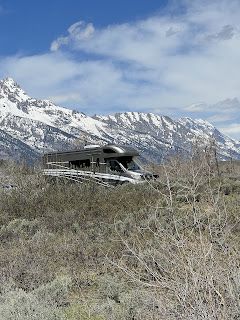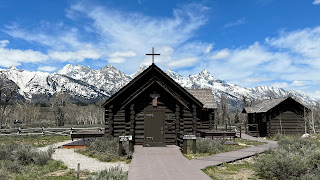Wednesday, May 25, 2022; Grand Teton and Craters of the Moon National Parks
It was nice to get a head start on Grand Teton from our boondocking site just inside the park entrance. It appeared that a couple of other parties had boondocked in the parking lots.
The Grand Tetons National park is focused on the Teton range, which makes for a striking backdrop.
Jackson Lake is partially natural, and partially man made through construction of a dam at the lake’s natural outlet. This raises the natural lake’s level flooding some of the prior natural valley. The lake level appeared to be close to the natural level because at the marina, many of the mooring floats were sitting on dry ground, and the float docks were several hundred feet down the bank from the high water marks. This is probably in anticipation of collecting spring run-off from the surrounding mountains and glaciers.
The city of Jackson was named after a fur trader who was instrumental in settling of the area. We learned that Jackson Hole simply means Jackson Valley, with the Hole being the valley left by subduction of part of the continental crust under the western part which was pushed up into the sky as the Tetons. So when people say Jackson Hole, they are referring to the valley where the city Jackson is situated.
There are several wildlife viewing areas where bison, elk and antelope are pretty easily see at a distance.
There is also a historical Mormon settlement in the valley.
The Snake River runs to the east of the Tetons. Ansel Adams famously photographed Grand Teton overlooking a bend in the Snake river. There is now literally a sign that says Ansel Adams stood here at the location where that famous photo was taken.
The historical Chapel of the Transfiguration and Snake River ferry crossing are situated at the south end of the park. Presidents Jimmy Carter and Bill Clinton both attended services in the Chapel. It is popular for weddings now even though it is quite small. There is a separate side building that is the Bride’s prep building.
The town of Jackson is quite touristy and busy with tourists walking the streets and checking out the numerous shops, restaurants, bars and galleries. We filled up the tank with 11.452gal @$5.599/gal with 26351 miles on the odometer (16.2mpg since last fill up in Cody).
We then made our way through the very agricultural southeastern part of Idaho, which has rolling hills and vast spreads of rangeland. As we headed down into the central plateau of Idaho, it became more desert like and there were lots of areas with chain link and barb wire fencing and signs warning unauthorized personnel to stay clear. The city of Arco is famous for its participation in the dawn of the nuclear era. Their claim to fame is “The First City Illuminated by Nuclear Power”. Well the story is actually a little darker. Arco was the sight of Experimental Breeder Reactor 1 or EBR-1. This was a small nuclear reactor that was used to produce a net gain in fissionable material, converting uranium to plutonium, and was also the first nuclear reactor to produce enough energy to produce electricity. It was able to power a total of 4 light bulbs, each rated 200 watts. So this first electricity producing nuclear reactor could crank out 800 watts.
While they were using EBR-1, they noticed that it was a bit unstable, and they couldn’t figure out what exactly the problem was. They eventually decided to shut the reactor down because they had just about gotten all the data they could from that experimental reactor. Their last experiment was therefore to see what would happen if they gradually increased the reactor output while reducing cooling water flow. Well, surprise, surprise- the reaction ran out of control, so they had to scram the reactor and seal up the containment facility. It was so radioactive inside that nobody was allowed to even peek for several months. There was also concern that the Soviets might think the US had violated a nuclear bomb testing treaty if there was any release of radiation from the containment facility.
When the were eventually able to see what had happened, they found the reactor core partially melted down- half of the fuel rods were fused into a molten mass. Thank goodness it was just an experimental reactor with an 800 watt output, or this meltdown could have been America’s first Chernobyl. They eventually figured out that the reactor design allowed some bending of the fuel rods which caused a positive feedback situation with regards to nuclear chain reactions. Subsequent American nuclear reactors had better designed fuel rod assemblies which are more fail safe. So real good came from the lessons learned in EBR-1.
It is likely Chernobyl was caused by the same defect in fuel rod design which lead to the EBR-1 meltdown.
There is no place to tour regarding this nuclear history- just a commemorative roadside sign and a city park.
We arrived at the Craters of the Moon National Park just as the Visitor Center was closing its doors at 4:30pm. We sprinted through the doors at 4:28pm. We were able to get a park map and instructions on how to register in the campground. We had learned that the campground has usually not been full so there was an excellent chance of us finding a site. The visitor center displays were small enough for us to glance through in just a minute or two.
We were able to find a nice campsite for our RV and put up out “This Site Is Occupied” signs on the picnic table and signpost, and then registered at the campground entrance. It is all electronic. We were able to camp for quite a discount with Janet’s Senior pass. Normally, admission to the park is $20 and it’s another $20 to camp, but with her pass, it was just $4. The campground had no running water or toilets today because of the potential for sub freezing weather, but they did have some pit toilets available. I imagine “later in the season”= Friday, Memorial Day Weekend, they will simply unlock the real bathroom doors and uncover the water hydrants.
We were able to see most of the park that was open. There were a few areas that were close because they were unstable, and the caves were all closed because of bat breeding season.
We did all the short loop trails, climbed to the top of Inferno Cone, and hiked the mile and back to see Tree Molds in a lava flow. The weather was breezy with a temperature in the 70’s, so it was comfortable. Overcast sky also helped. By the time we finished the park’s loop drive and got back to our campsite, the campground appeared to be nearly full, with just a handful of openings left.
We had showers because hiking around in the volcanic cinders left us very dusty. We made dinner with ziti pasta, canned chicken breast meat, the remainder of our previously opened Bertolli marinara sauce, broccoli and some added cheese.
Craters of the Moon is a designated “dark sky” viewing area, so we were hoping to be treated to a view of the Milky Way, but the Milky Way wasn’t really visible. I did happen to capture the ISS streak across the sky in an 8 second timed exposure of the night sky.































No comments:
Post a Comment
Note: Only a member of this blog may post a comment.